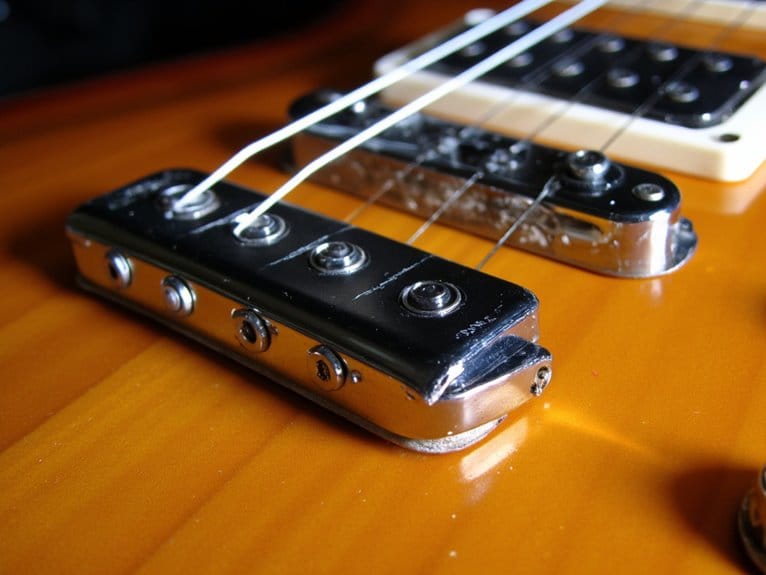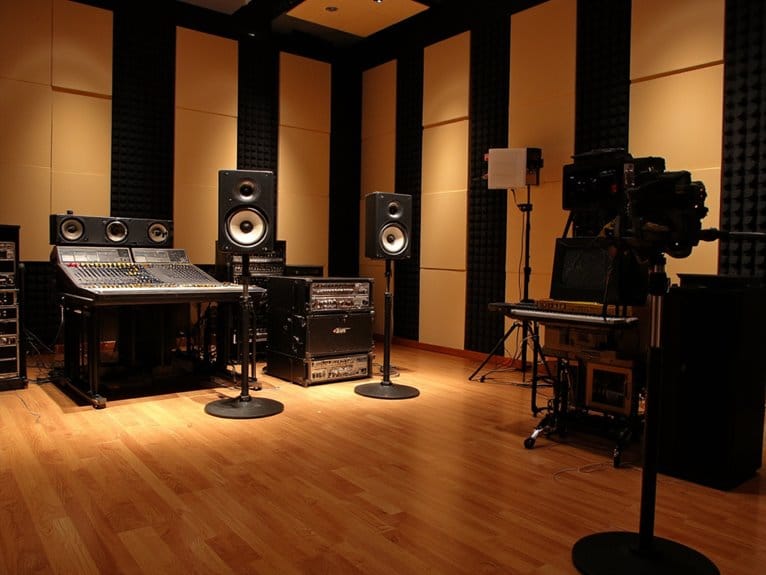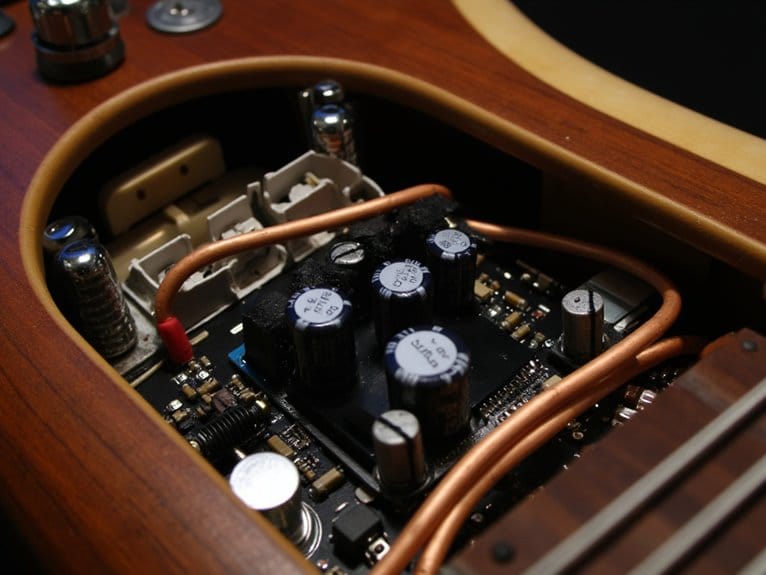Guitar Pickup Placement and Its Effect on Tone
Your pickup’s position dramatically affects your guitar’s tone because each location captures different string vibration patterns. Neck pickups, positioned where strings vibrate most freely, deliver warm, full-bodied sounds with emphasized fundamentals around 2.5-3 kHz, while bridge pickups capture tighter vibrations, producing bright, articulate tones above 4 kHz with 5-7 dB higher output. Middle pickups balance these extremes, resonating between 3-3.5 kHz for versatile tonal character that’ll transform your understanding of sonic possibilities.
We are supported by our audience. When you purchase through links on our site, we may earn an affiliate commission, at no extra cost for you. Learn more.
Notable Insights
- Neck pickups capture fuller fundamental frequencies and warmer tones due to maximum string vibration amplitude at the midpoint.
- Bridge pickups emphasize brighter overtones and higher harmonics, producing clearer articulation with 5-7 dB higher output levels.
- Middle pickups offer balanced tonal characteristics between neck warmth and bridge brightness, resonating around 3-3.5 kHz frequency range.
- Pickup height adjustments alter magnetic field strength, directly affecting tone customization and the balance between sustain and clarity.
- Different genres favor specific pickup positions: blues/jazz prefer neck warmth while rock/metal utilize bridge aggression for distortion.
Understanding How Pickup Position Shapes Fundamental Tone Characteristics
Three fundamental principles govern how pickup placement dramatically alters your guitar’s voice, and I’ve spent countless hours experimenting with different configurations to understand these physics-based relationships that shape every note you play.
First, string displacement varies dramatically along its length, with maximum amplitude occurring near the midpoint where neck pickups capture fuller fundamental frequencies. Strategic positioning with staggered pole pieces ensures balanced string output across the entire pickup configuration.
Second, harmonic content shifts based on proximity to the bridge, where higher string tension emphasizes brighter overtones despite reduced displacement. The maple neck construction commonly found in electric guitars contributes to bright, articulate tone transmission that complements bridge pickup characteristics.
Third, pickup influence extends beyond simple positioning—the magnetic field’s interaction with string velocity creates frequency-dependent sensitivity that affects your overall sound signature. Different pickup types further influence this interaction, as single-coil pickups offer bright, clear sound while humbuckers provide fuller, warmer tone characteristics. Many modern configurations feature H-H configurations that deliver rich tones ideal for rock while offering noise-canceling properties.
Understanding these mechanics enables precise tone customization, allowing you to strategically choose pickup positions that complement your playing style and musical goals. Additionally, pickup height adjustments provide another layer of tonal control by changing the magnetic field strength and its interaction with string vibrations.
The Science Behind Harmonic Content and Timbre Variations by Location
When I first started examining the relationship between pickup placement and harmonic content, I discovered that the science goes far deeper than simple “neck sounds warm, bridge sounds bright” generalizations that most players accept without question.
Through harmonic analysis, I’ve learned that resonance zones create distinct frequency harmonics patterns along your string’s length, directly affecting timbre perception and pickup characteristics. Your neck pickup captures stronger fundamental frequencies and lower harmonics because it’s positioned near the string’s midpoint, while bridge pickups detect higher-order harmonics closer to the fixed anchor point.
These amplification dynamics explain why different resonance effects occur at each position. The pickup width also creates a comb filter effect that varies between single coils and humbuckers, further shaping your instrument’s frequency response. The choice between AlNiCo II magnets and AlNiCo V magnets significantly influences tonal qualities such as sustain and clarity, with AlNiCo V providing enhanced dynamics and pronounced midrange characteristics. Many manufacturers incorporate wax-potted construction to eliminate unwanted squealing and feedback during overdrive conditions, which becomes particularly important when exploring different pickup positions at higher gain settings. Understanding these tonal techniques helps you make informed decisions about pickup selection, rather than relying on vague descriptions that miss the underlying physics. Proper pole spacing alignment ensures optimal string detection and maintains tonal balance across all pickup positions on your guitar.
String Vibration Patterns and Their Interaction With Pickup Placement
When you place your pickup at different positions along the string, you’re fundamentally choosing which parts of the string’s complex vibration pattern you want to emphasize or minimize in your final tone.
The fundamental frequency has its maximum vibration amplitude at the string’s center, while harmonic overtones create their own distinct node and antinode patterns that interact with your pickup location in fascinating ways.
Understanding how these vibration amplitude effects work gives you the power to sculpt your guitar’s harmonic content simply by moving your pickup a few millimeters in either direction.
Fundamental Frequency Capture Points
Understanding how your guitar’s strings vibrate reveals the fundamental science behind why pickup placement dramatically affects your tone.
When you pluck a string, it creates a standing wave with maximum displacement near the midpoint, where the fundamental frequency produces its strongest signal output. Your neck pickup, positioned closer to this sweet spot, captures more of that fundamental energy, resulting in a warmer frequency response with enhanced bass and body.
Conversely, your bridge pickup sits where string displacement is smaller, detecting less fundamental signal but emphasizing the brighter harmonics instead. This positioning difference explains why neck pickups sound fuller and rounder while bridge pickups deliver that sharp, cutting attack you hear in lead guitar work.
Harmonic Node Positioning
While most guitarists focus on pickup height and magnet strength, I’ve found that the invisible science of harmonic nodes creates the most dramatic tonal shifts you’ll experience on your instrument. Understanding harmonic distribution fundamentally changes how you approach pickup optimization, because each harmonic creates specific points along your strings where vibration amplitude drops to zero.
| Pickup Position | Harmonic Effect |
|---|---|
| Near neck | Warmer, fewer high harmonics |
| Bridge position | Brighter, captures higher frequencies |
| Node locations | Minimal output for specific harmonics |
| Between nodes | Maximum harmonic amplitude |
When you fret notes, you’re actually shifting these node positions, which explains why your tone changes dramatically across the fretboard. This node interaction determines which frequencies your pickups detect, making strategic placement essential for achieving your desired sound character. Just as neck profiles affect comfort and playability for acoustic guitars, the physical positioning of pickups relative to harmonic nodes directly influences the tonal characteristics and frequency response of electric guitars.
Vibration Amplitude Effects
Beyond the mathematical precision of harmonic nodes lies the physical reality of how your strings actually move, and I’ll admit it took me years to appreciate how markedly vibration amplitude affects pickup performance.
Near your neck, strings swing in wider arcs, creating stronger signals dominated by fundamental frequencies and lower harmonics that produce those warm, bass-rich tone colors we associate with rhythm playing.
Conversely, bridge positioning restricts string movement considerably, generating smaller vibration amplitude but higher velocity components that emphasize treble frequencies and attack characteristics.
Your pickup fundamentally reads these amplitude differences as tonal variations, with neck positions delivering fuller, rounder sounds while bridge locations provide that bright snap and clarity that cuts through dense mixes.
Professional musicians understand that pickup quality directly influences how these amplitude variations translate into the final sound output, making the choice of pickup technology as crucial as its placement along the string’s vibration path.
Understanding how midrange frequencies between 100 Hz and 5 kHz interact with pickup placement becomes essential for capturing the true character of your guitar’s voice, whether you’re aiming for clean articulation or overdriven saturation.
The construction materials used in your guitar, from quality woods to engineered components, significantly impact how these vibrations resonate through the instrument and interact with your pickup’s magnetic field.
Signal Response Differences Across Neck, Middle, and Bridge Positions
When you switch between pickup positions on your guitar, you’re fundamentally altering three vital aspects of your signal: how different frequencies are captured and emphasized, the overall amplitude or “hotness” of your output, and how sensitively the pickup responds to your playing dynamics.
I’ve found that understanding these signal response differences becomes essential once you start crafting specific tones, since each pickup position effectively acts like a different microphone placement on the same vibrating string.
Your neck pickup will deliver warmer, fuller signals with higher output levels, while your bridge pickup produces brighter, more articulate signals with enhanced treble harmonics.
Your middle pickup offers that balanced middle ground between these extremes. Understanding these tonal characteristics helps when selecting effects that complement each position, as chorus pedals can add depth and richness to enhance the natural voice of any pickup configuration.
To further shape these inherent pickup characteristics, many bassists utilize preamp pedals with 3-band EQ controls to enhance tonal flexibility and customize their sound across different pickup positions. Additionally, distortion pedals can transform these natural pickup voices into aggressive, saturated tones while maintaining the fundamental character differences between positions.
Frequency Response Variations
As someone who’s spent countless hours tweaking pickup heights and switching between positions during recording sessions, I can tell you that the frequency response differences between neck, middle, and bridge pickups create some of the most dramatic tonal shifts you’ll encounter on any electric guitar. The magnetic field strength and string dynamics at each position fundamentally alter how frequencies are captured, affecting everything from pickup balance to overall tonal diversity.
| Position | Resonant Peak | Harmonic Emphasis | Tonal Character |
|---|---|---|---|
| Neck | 2.5-3 kHz | Fundamentals/Low | Warm, Rich |
| Middle | 3-3.5 kHz | Balanced Spectrum | Brassy, Neutral |
| Bridge | 4+ kHz | Higher Harmonics | Bright, Cutting |
| Single Coil | ~4 kHz | Treble-Heavy | Sharp, Clear |
| Humbucker | ~2.5 kHz | Mid-Focused | Dark, Thick |
These positional effects create natural frequency modulation that enhances tone shaping possibilities across your guitar’s range. Similar to how electronic drum modules utilize velocity-sensitive pads to capture dynamic playing variations, pickup positioning allows guitarists to access different tonal territories through strategic signal capture at various string vibration points.
Amplitude Output Differences
While frequency response differences reveal how each pickup position colors your tone, the amplitude variations between neck, middle, and bridge pickups create equally significant changes in signal strength that directly impact how your guitar sits in a mix and responds to amplifier gain stages.
Bridge pickups typically deliver 5-7 dB higher output amplitude than neck positions, with humbuckers reaching peak voltages around 800 mV compared to the neck’s 450 mV. These pickup characteristics stem from bridge pickups being wound “hotter” to compensate for reduced string vibration near the bridge saddle.
You’ll notice this difference when switching between positions—your bridge pickup drives amp distortion harder while your neck pickup provides cleaner headroom, creating distinct dynamic responses that shape your playing approach. Traditional Telecaster models feature single-coil pickups in both neck and bridge positions, which deliver the characteristic bright, crisp tone with notable output differences between positions.
Dynamic Sensitivity Changes
Beyond output amplitude differences, each pickup position responds to your playing dynamics in fundamentally different ways, transforming how your guitar reacts to subtle changes in pick attack, finger pressure, and string vibration intensity.
Your neck pickup’s sensitivity creates smoother, warmer responses that emphasize bass frequencies and sustain, making legato passages feel effortless while minimizing picking noise.
The bridge position’s pickup sensitivity delivers sharper transient response with pronounced treble emphasis, revealing every nuance of your attack but sometimes exposing playing imperfections.
Meanwhile, your middle pickup balances these extremes, offering moderate dynamic response that’s versatile for rhythm work. Just as velocity-sensitive keys on MIDI controllers respond differently to touch intensity, your guitar’s pickup positions translate playing dynamics into distinct tonal characteristics.
This placement impact means you’ll naturally adjust your playing style for each position, unconsciously adapting your touch to maximize each pickup’s unique dynamic characteristics. Professional recording setups often require clean, transparent gain from preamps to accurately capture these subtle pickup position differences without introducing unwanted coloration.
When amplifying these tonal differences, consider how your amp’s overdrive gain controls interact with each pickup position’s natural sensitivity to enhance or tame these dynamic responses.
Matching Pickup Positions to Musical Genres and Playing Styles
When I first started matching pickup positions to different musical styles, I discovered that understanding the relationship between pickup placement and genre requirements can dramatically transform your guitar’s voice to suit specific musical contexts.
Your pickup preference should align with your primary playing style, as tone variation between positions serves distinct musical purposes.
Blues and jazz players typically gravitate toward neck pickups for warm, smooth textures that complement expressive phrasing, while rock and metal guitarists favor bridge humbuckers for aggressive attack and cutting presence.
Country musicians often select bridge single-coils for that characteristic twang, and versatile players benefit from middle positions or combination settings. Many Telecaster pickups use Alnico magnets to provide the warm vintage tones that are particularly well-suited for country and blues applications.
Understanding these genre-specific requirements helps you make informed decisions about pickup selection and positioning for ideal tonal matching.
For extreme metal applications, high-output pickups ranging from 15k to 20k ohms are essential for producing the aggressive sound and maximum sustain needed for crushing heavy riffs.
Technical Considerations for Optimal Pickup Installation and Setup
After years of installing pickups in everything from vintage Stratocasters to modern metal machines, I’ve learned that proper installation technique can make the difference between a pickup that sounds incredible and one that leaves you wondering why you spent the money.
Pickup height affects everything from output level to tonal balance, while proper wiring techniques prevent the dreaded hum that’ll drive you crazy during late-night practice sessions. I always start by documenting the existing setup with photos, then carefully desolder connections using just enough heat to avoid damaging components.
| Installation Step | Single Coil | Humbucker | Piezo |
|---|---|---|---|
| Height Adjustment | 2-3mm from strings | 1.5-2.5mm from strings | Under saddle contact |
| Wiring Complexity | Basic 2-wire | 4-wire series/parallel | Preamp required |
| Mounting Method | Direct to pickguard | Mounting rings | Saddle slot |
| Shielding Needs | High priority | Medium priority | Minimal |
| Output Level | Low to medium | High | Variable |
Frequently Asked Questions
Can Pickup Placement Affect Guitar Intonation and Tuning Stability?
Your pickup positioning won’t affect guitar intonation or tuning stability since these depend on bridge saddles and string tension. However, you’ll notice pickup placement notably impacts tonal balance and harmonic content without changing actual pitch.
How Does Pickup Placement Interact With Different String Gauges and Materials?
You’ll find string gauge interaction requires pickup height adjustments—heavier strings need lower placement to avoid muddiness. Material resonance varies too; brighter steel strings benefit from bridge positioning while warmer nickel strings work better near the neck.
Do Active Pickups Respond Differently to Placement Than Passive Pickups?
Active pickup advantages include consistent tone regardless of placement changes, while passive pickup nuances shine through varied positioning. You’ll notice actives maintain clarity everywhere, but passives offer more expressive tonal diversity when you adjust their placement.
On a final note
You’ve now got the knowledge to transform your guitar’s voice through strategic pickup placement, whether you’re chasing that warm neck humbucker jazz tone or the biting clarity of a bridge single-coil. Don’t be afraid to experiment with blending positions—that’s where the real magic happens. Remember, there’s no wrong choice, just different flavors that’ll serve your musical vision and genre requirements perfectly.






